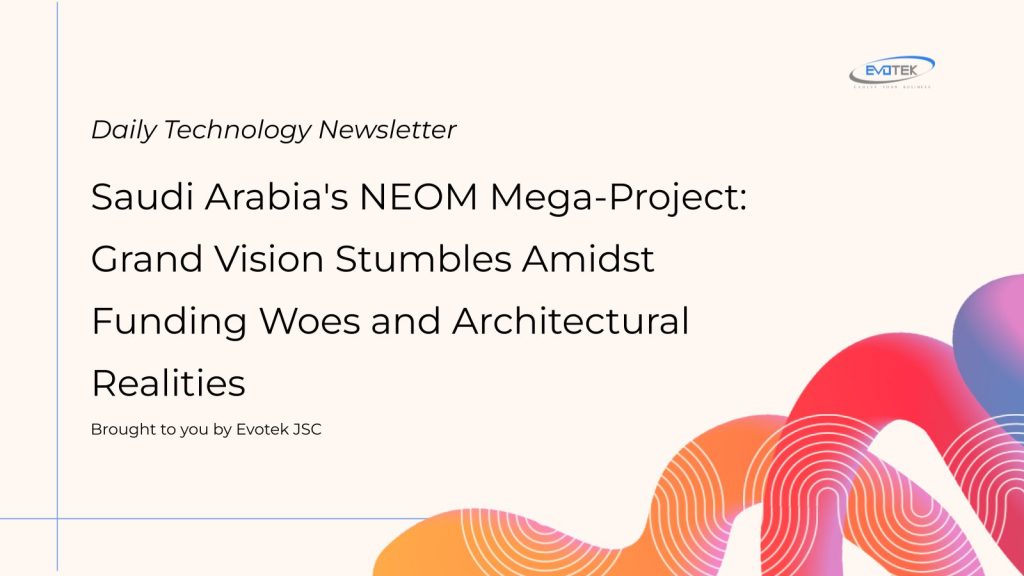Saudi Arabia’s ambitious NEOM mega-project, once heralded as a beacon of future urban living, appears to be facing significant challenges and is reportedly on the brink of collapse. A recent investigative report by the Financial Times, drawing on high-level internal sources, paints a vivid picture of systemic dysfunction and profound failure at the core of this monumental, futuristic city endeavor.
The Line: A Vision Confronts Engineering Realities
At the heart of the NEOM project lies The Line, a proposed 105-mile-long linear city initially projected to house up to 9 million residents by 2030. This futuristic urban development was conceived with breathtaking architectural innovations, many of which are now proving impossible to execute. Among the most striking, and problematic, was the concept of “the chandelier”—an upside-down, 30-story building intended to suspend precariously over a gateway marina.
Architects involved in the project reportedly warned Tarek Qaddumi, The Line’s executive director, about the inherent dangers and implausibility. Concerns were raised about the physics of suspending such a massive structure, with one architect noting, “You do realise the earth is spinning? And that tall towers sway?” The terrifying scenario described was that the chandelier could “start to move like a pendulum,” gain speed, and eventually “break off,” leading to a catastrophic collapse into the marina below. These fundamental engineering challenges underscore the disconnect between the project’s grand aspirations and practical construction limits.
NEOM’s Future Scaled Back Amidst Mounting Doubts
Despite an estimated $50 billion already invested, the desert landscape designated for NEOM is currently marked by little more than pilings and extensive trenches. Sources indicate that Prince Mohammed bin Salman, the chairman of NEOM, has significantly scaled back the initial phases of the development. While NEOM officials maintain that The Line remains a “strategic priority” and a “new blueprint for humanity,” they now describe it as a “multi-generational development of unprecedented scale and complexity,” signaling a much longer timeline than initially envisioned.
Internal sentiment among project workers suggests widespread skepticism regarding the completion of The Line. Many employees reportedly believe that while technically feasible, the financial commitment required is simply untenable. Consequently, construction activity across NEOM has decelerated considerably, with only select components, such as the desert ski resort Trojena (slated for the 2029 Asian Winter Games), maintaining significant momentum. A former employee bluntly stated that the project’s ultimate failure is an open secret, with the challenge now being how to gently relay this reality to MBS.
Foreign Investment Fails to Materialize for NEOM’s Grand Vision
A critical factor in NEOM’s current predicament is its inability to attract the substantial foreign investment required for such an astronomically expensive venture. As the project’s ambitious designs have struggled to move beyond blueprints, securing external capital has proven increasingly difficult. The Financial Times report highlights that senior executives continuously sought more funds, often with The Line competing against other facets of the broader NEOM initiative.
While some affluent Saudi families contributed modest sums, the significant foreign backing Riyadh had anticipated has failed to materialize. This severe shortfall in funding has led a senior construction manager to express strong doubts that The Line will ever be fully realized, underscoring the severity of the financial challenges facing the futuristic city project.
Reputational Fallout and Unfulfilled Modernization Goals
The faltering progress of the NEOM project threatens to inflict significant damage on Saudi Arabia’s international reputation. Long a key regional ally, the Kingdom has sought to use NEOM as a public relations vehicle, aiming to present itself as a forward-thinking, technocratic hub aligned with Western investments in AI, renewable energy, and electric vehicles.
However, instead of symbolizing modernization and adaptation, NEOM risks becoming a stark metaphor for the Kingdom’s struggle to truly embrace the future and shed its traditional image. The grand vision is further clouded by serious ethical concerns: reports from Human Rights Watch highlight the tragic loss of life among the thousands of precarious laborers employed on the mega-project. The image of a hubristic development rising from the desert, reportedly built upon the sacrifices of countless workers, deeply contradicts the narrative of modernism Saudi Arabia hoped to project.
Saudi Arabia’s Shifting Focus: AI as a More Promising Path
In contrast to its struggling urban development ventures, Saudi Arabia appears to be finding more success with an alternative economic diversification strategy: heavy investment in the global artificial intelligence (AI) sector. The Kingdom has strategically positioned itself as an indispensable infrastructure provider for the burgeoning computing boom, pouring resources into data centers and forging significant deals with Western tech giants. This pragmatic approach to the AI frenzy seems a far more reliable bet for economic growth than the multi-trillion-dollar dream of a futuristic tourist and residential hub, at least in the short to medium term.
As the challenges mount for NEOM and its flagship component, The Line, the project underscores the immense difficulties in translating utopian urban visions into tangible realities, particularly when faced with engineering complexities, financial hurdles, and critical human rights scrutiny. The future of Saudi Arabia’s ambitious futuristic city remains uncertain, prompting a reassessment of its path to modernization.

 日本語
日本語 한국어
한국어 Tiếng Việt
Tiếng Việt 简体中文
简体中文